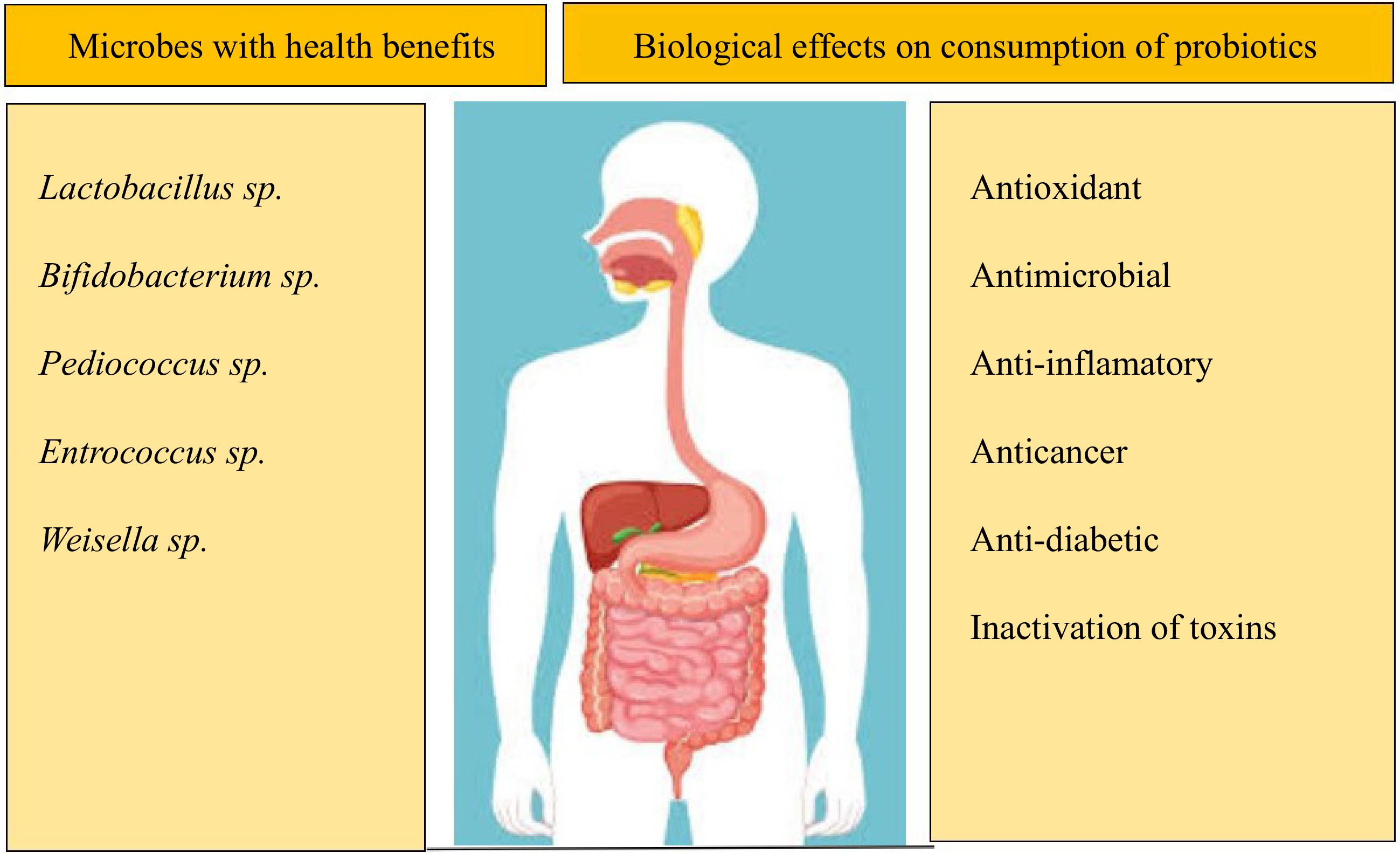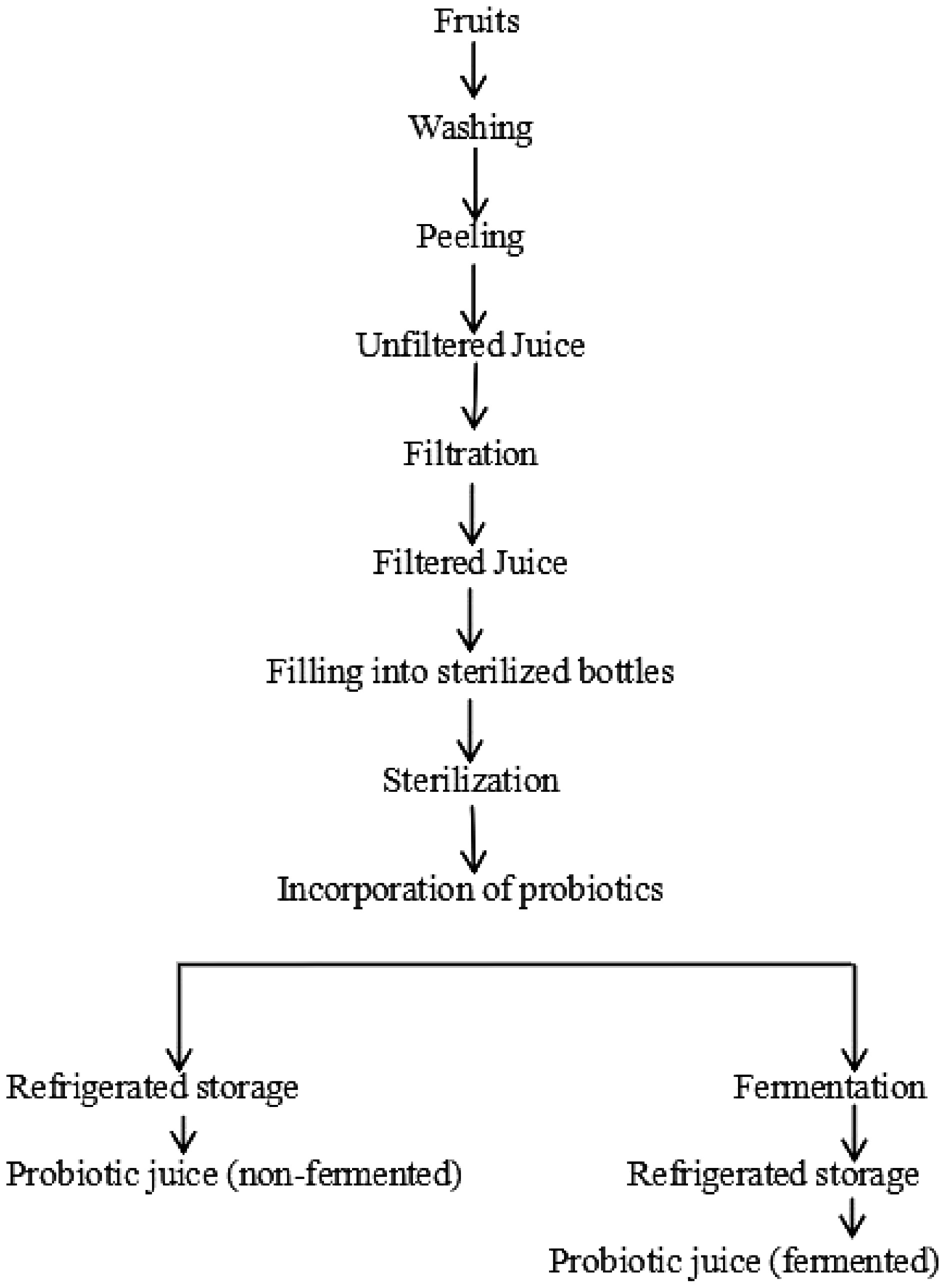-

Figure 1.
Relationship of the intake of different probiotic species with their bioactive properties.
-

Figure 2.
Classification of sources of probiotics.
-

Figure 3.
Stages in probiotication of fruits and vegetables juice.
-

Figure 4.
Formation of probiotics enriched fermented and non-fermented fruit juice.
-

Figure 5.
Health benefits of consuming probiotics.
-
Year Probiotic Discovery details Ref. 1983 Lactobacillus rhamnosus Known for its survival in the gastrointestinal tract [12] 1980s Lactobacillus reuteri Discovered as a natural inhabitant of the gut [21] 1974 Streptococcus thermophilus Important in yogurt and certain cheese production [19] 1970s Bifidobacterium longum Commonly found in the human intestines and feces [18] 1960s Lactobacillus casei Identified for its role in dairy fermentation [20] 1957 Bifidobacterium breve Discovered as a part of the human intestine microbiota [19] 1950s Bifidobacterium bifidum Recognized in the intestines of breastfed infants [18] 1923 Saccharomyces boulardii Isolated from lychee and mangosteen fruit [16] 1905 Lactobacillus bulgaricus Discovered by Stamen Grigorov in Bulgaria [15] Table 1.
List of some probiotic strains along with their discovery details.
-
Probiotic Mechanism of action Health benefits Sources Ref. Lactobacillus rhamnosus Competitive elimination of pathogens, production of lactic acid and bacteriocins Reduce prevalence of diarrhoea,
enhances gut healthYogurt, fermented foods [22,23] Bifidobacterium bifidum Modulate immune response, improve intestinal barrier function Reduce symptoms of IBS, support
immune healthProbiotic supplements, dairy products [31,32] Lactobacillus acidophilus Produce short-chain fatty acids (SCFAs), inhibit growth of harmful bacteria Aid lactose digestion, improve
vaginal healthYogurt, kefir [26,27] Saccharomyces boulardii Compete with pathogens for binding sites, produces antimicrobial compounds Prevents antibiotic associated
diarrhoea, restores gut floraProbiotic supplements [17,28] Lactobacillus reuteri Produce hydrogen peroxide,
enhance mucosal immunityReduce gingivitis, improves
skin healthFermented milk products [29,30] Bifidobacterium longum Ferments dietary fibres, produce SCFAs and vitamins Supports digestive health,
reduces inflammationProbiotic supplements, yogurt [24,25] Table 2.
Probiotic strains and their mechanisms of action.
-
Application Mechanism of action Potential health benefits Relevant probiotic strains Examples Ref. Food industry Enhance gut microbiota,
improves food safety through pathogen inhibitionSupports digestive health,
increases food
preservationLactobacillus acidophilus, Lactobacillus casei, Lactobacillus plantarum Yogurt, kefir,
drinks, etc.[78] Functional foods Modulateimmune response, producebioactive compounds Reduceinflammation,
enhance nutrient
absorptionLactobacillus acidophilus, Lactobacillus casei, Streptococcus thermophilus Probiotic fortified juices, probiotic enhanced snack bars, etc. [27] Pharmaceuticals Delivertherapeutic molecules,
Compete with pathogensTreat gastrointestinal
diseases, support mucosal
healthLactobacillus rhamnosus GG, Saccharomyces boulardii Florastor, align, culturelle, etc. [79] Next generation probiotics Utilize non-conventional strains, enhanceviability through encapsulation techniques Targets metabolic
syndromes, improve gut barrier functionAkkermansia muciniphila, Faecalibacterium prausnitzii,
Clostridium butyricumEvolus, BIO-tract, etc. [80] Disease prevention Competitive exclusion of pathogens, detoxify environmental pollutants Prevents antibiotic-associated diarrhoea, reduce risk of IBD and obesity Bifidobacterium lactis BB-12,
Saccharomyces boulardiiAlign (Bifidobacterium 35624), etc. [81] Gut health
restorationImprove intestinal barrier integrity,
modulate gut-brain axisAlleviatesymptoms of anxiety and depression, enhance nutrient metabolism Lactobacillus rhamnosus GG,
Saccharomyces boulardiiGarden of Life RAW Probiotics, etc. [82] Mental health and
gut-brain axisModulate gut microbiota composition, produce neurotransmitters, influence the hypothalamic-pituitary-adrenal (HPA) axis Reduce anxiety and
depression symptoms, enhancemoodLactobacillus rhamnosus, Bifidobacterium longum VSL#3 (a high-potency probiotic blend), etc. [83,84] Metabolic health
and obesityRegulate energy metabolism,
modulate lipid metabolism,
produces short-chain fatty acids (SCFAs)Aids weight management,
improve insulin sensitivityAkkermansiamuciniphila, Lactobacillus gasseri Activia, LG2055, etc. [85,86] Immune modulation and allergies Balance Th1/Th2 immune response, enhance regulatory T cell (Treg) function, produces
anti-inflammatory cytokinesReduces allergic reactions,
improves immune toleranceLactobacillus reuteri, Bifidobacterium bifidum Align, flostor, etc. [87] Cancer prevention
and adjunctive
therapyEnhance anti-tumor immunity, modulate gut microbiota to inhibit carcinogenesis, produce bioactive compounds that may have
anti-cancer propertiesReduces cancer risk,supportconventional cancer treatments Lactobacillus acidophilus, Bifidobacterium longum VSL#3, LGG, etc. [88,89] Table 3.
Emerging applications of probiotics.
Figures
(5)
Tables
(3)